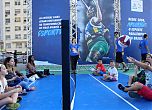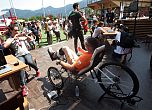
Tijuca may not be on the established route for many visitors to Rio, but within the huge, laid-back and heavily residential neighbourhood exist both a shrine of green tranquility and an oval of sporting obsession. Close to the world’s second largest urban forest, the Maracanã may be closed for a pre-World Cup refit, but is still the most famous local landmark. Arrive by bus or car along Avenida Maracanã and it is impossible to miss the famous behemoth of Latin American footballing prowess, the façade of which is preserved as a site of national heritage, while the inside is completely dug out and replaced.
Alternatively, three Metrô stations serve the region, a useful indication of its size (and a fourth is due to open in 2014). Afonso Pena, São Francisco Xavier and Saens Peña stations run east to west towards the mountains, and grab a taxi from the latter if it is indeed upwards that you want to continue.
To get into the forest, simply turn onto Rua Conde de Bonfim and follow it to Alto da Boa Vista square (bus stop 301/302), and the entrance to the park. Open from 8am-5pm (6pm in summertime), there are well-developed and sign-posted trails to Pico da Tijuca (around 90 minutes) and Pico do Papagaio (45 minutes), the two most popular routes offering a solid hike and spectacular views at their apex. Dozens of waterfalls and some impressive caves are also ripe for the exploring by anyone keen to go a little off-piste, with trails and tips available from the Terra Brasil website.
Back down at sea level, a plethora of decent restaurants await the building apetites, most at considerably more appealing prices than in Zona Sul. Fifteen minutes from the park is Otto, a relaxed bar-restaurant where even the bedraggled hiker need not feel uncomfortable with their appearance. The chopp will be richly deserved, and the Germanic take on carioca cuisine throws up some good, hearty refuelling options.
Lareira (Rua Major Ávila 200, 21 2264 5635) also serves up some great steaks, the filé mignon a campanha serving up to five people depending on the hunger levels, as juicy and tender as you would expect from this part of the world. The nearby ‘Polo Gastronomico’ – gastronomic quarter – is the place to go for a little more choice, with a branch of the ever-popular seafood specialists Siri (Rua dos Artistas 2, 21 2208 6165), the glorified outdoor bar Buxixo, and another carioca classic, Garota da Tijuca (Praça Varnhagem 5, 21 2569 0197) doing the simple things well. Umas e Ostras (Rua Barão de Mesquita 235, 21 2568 7128) is another wonderfully traditional Brazilian seafood specialist, where the whole grilled fish do battle with unusual combinations like salmon in passion fruit sauce with fried banana (R$79).
For anyone concentrating on the beer side of things, Praça Varnhagen is replete with options, from the ever popular and delightfully named Universo da Cerveja (Rua Almirante João Cândido Brasil 134, 21 2268 6894) to Bar do Adão with its superior bar snacks that include an impressive pastel menu (brie and apricot, anyone?). Sókana (Avenida Maracanã 766, 21 2567 7082) gets mobbed on match days, the bar being a major meeting point for fans of all teams which makes for an entertaining spectator sport of its own. Huge screens mean the action is followed closely when there’s no home game or a sold-out classico is being meted out over the road.
Shopping options are somewhat limited to the huge Shopping Tijuca (Avenida Maracanã 987, 21 2176 6000) mall, but of course there are a few hidden gems lurking too. Nigri (Rua Uruguai 379, 21 2268 6896) is an excellent little deli where the regulars come to drink and while away the days with the personable owner Júlio. Stocking around 120 imported and national beers, it is one of the few places round here you’ll be able to get your hands on a can of Guinness (R$19).
The essence of the region reveals itself to the fullest through the sounds emanating from the squares and venues, and it is home to some of the most traditional rodas de samba around. The land of musical greats like Aldir Blanc and Tim Maia, it has a rich musical history that is only now really returning after a somewhat violent decade from the early ‘90s troubled the peace, gradually eroded with the growing economy.
A visit could effectively start and end at the Café Cultural Diminuta, where the breakfasts are as popular as the evening live choro and samba shows. Clube Renascença is home to regular samba events, with Monday’s Samba do Trabalhador one of the longest-running of its kind, drawing a party atmosphere from as early as 4pm for a weekly tradition that reflects perfectly the attitude of the neighbourhood as a whole.




Thanks for the comments, Douglas. More venues will be added shortly and we are always updating so thanks for the tips
Posted on Wed 07 Dec 2011 13:59:57
Nice to see a guide on something other than South Side Rio. But I disagree with the "limited shopping" options. I live in Tijuca and rarely go to the shopping mall. ALL of Conde de Confim ave. and Haddock Lobo Ave. has shops! Also, while I agree with the restaurants mentioned, there are MANY more restaurants in the area. Great little Boteco is "Joaquim e Teresina" on Rua Almirante Gavião. And a new Bar/restaurant called "Odorico" is now open on the corner of Dr. Satamini and Prof. Gabizo. Abraço
Posted on Wed 07 Dec 2011 05:37:51